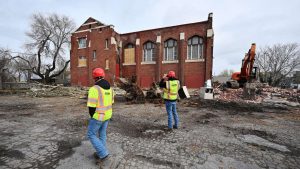Coal Fired power plant demolished in planned implosion
Published by John on
Leveled in less than 30 seconds, Stanton Station coal-fired power plant, the oldest in Great River Energy’s North Dakota fleet, was erased from the west bank of the Missouri River in Mercer County.
“It should’ve never have happened,” Hubert Sailer, of Stanton, said of the demolition with a hint of sadness from behind the wheel of his truck as he waited for the fall of his longtime workplace. Sailer worked at the plant, first from ‘66 to ‘74, then on and off as a boilermaker in the years after. “A lot of hours,” he said of the many shifts spent firing up the first unit and building the second that brought the plant to its 188-megawatt capacity.
GRE announced Stanton Station’s closure in July 2016. Demolition work, gutting the plants innards, started in November. Then Thursday, nearly 52 years since the plant began operations, 108 detonation points tumbled the 270-foot concrete stack and the buildings that had housed the boilers, spokesman Lyndon Anderson said.
Crews will spend the next three to four months sorting through the rubble, recycling the majority of the scraps, said GRE Vice President and Chief Generation Officer Rick Lancaster. By mid-winter, most of the material will be gone. In the spring, the basement will be filled and the site graded and seeded back to prairie. GRE’s substation on site will remain operational.
The plant was originally built, along with a transmission line, to provide power to Grand Forks, Lancaster said.
“In the end what we were doing was offering the plant into the MISO market on an hourly basis and that’s what doomed the plant,” he said. “It wasn’t competitive in the MISO market. We were losing money. We responded to the market signal and decided to close the plant.” MISO, or Midcontinent Independent System Operator, is a regional transmission organization which serves as an open market for its members to buy and sell power. Lancaster said GRE’s other two coal plants, Coal Creek Station near Underwood and Spiritwood Station near Jamestown, have the benefits of being larger and more efficient, as well as having the ability to sell steam and coal ash as byproducts. “The plant will always be remembered as a pioneer in the coal industry as discoveries here have made other plants safer,” Anderson said in a statement.
JESSICA HOLDMAN Bismarck Tribune




